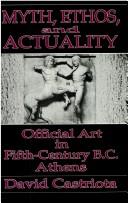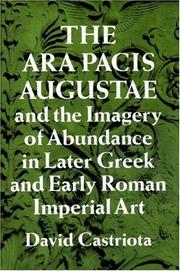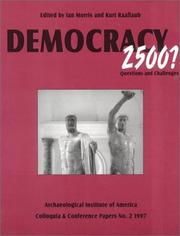| Listing 1 - 6 of 6 |
Sort by
|

ISBN: 0299133540 9780299133542 Year: 1992 Publisher: Madison (Wis.): University of Wisconsin press,
Abstract | Keywords | Export | Availability | Bookmark
 Loading...
Loading...Choose an application
- Reference Manager
- EndNote
- RefWorks (Direct export to RefWorks)
Art, Greek. --- Art patronage --- Art and state --- Art, Greek --- Arts patronage --- Business patronage of the arts --- Corporations --- Maecenatism --- Patronage of art --- Art and industry --- Greek art --- Art, Aegean --- Classical antiquities --- Art, Greco-Bactrian --- Art --- Arts --- Politics and art --- State and art --- Art and society --- Cultural policy --- Education and state --- Government policy --- Art patronage - Greece. --- Art and state - Greece.

ISBN: 0691037159 Year: 1995 Publisher: Princeton (N.J.) University press
Abstract | Keywords | Export | Availability | Bookmark
 Loading...
Loading...Choose an application
- Reference Manager
- EndNote
- RefWorks (Direct export to RefWorks)
Ara Pacis (Rome, Italy) --- Friezes --- Marble sculpture, Roman --- Peace in art --- Plants in art --- Relief (Sculpture), Roman --- Sculpture, Hellenistic --- Hellenistic sculpture --- Roman relief (Sculpture) --- Roman marble sculpture --- Altar of Augustan Peace (Rome, Italy) --- Altar of Peace (Rome, Italy) --- Altar of Peace of Augustus (Rome, Italy) --- Ara Pacis Augustae (Rome, Italy) --- Influence --- Sculpture, Greek --- Architecture --- Decoration and ornament --- Altars --- Details

ISBN: 078724466X 9780787244668 Year: 1998 Volume: no. 2 Publisher: Dubuque, Iowa : Kendall/Hunt,
Abstract | Keywords | Export | Availability | Bookmark
 Loading...
Loading...Choose an application
- Reference Manager
- EndNote
- RefWorks (Direct export to RefWorks)
Democracy --- Démocratie --- Athens (Greece) --- Athènes (Grèce) --- Politics and government. --- Politique et gouvernement --- Democracy. --- History --- Greece
Book
ISBN: 9780691193960 Year: 2018 Publisher: Princeton, NJ
Abstract | Keywords | Export | Availability | Bookmark
 Loading...
Loading...Choose an application
- Reference Manager
- EndNote
- RefWorks (Direct export to RefWorks)
Book
ISBN: 9780691655161 0691655162 9780691656588 0691656584 Year: 2018 Publisher: Princeton (N.J.) : Princeton University Press,
Abstract | Keywords | Export | Availability | Bookmark
 Loading...
Loading...Choose an application
- Reference Manager
- EndNote
- RefWorks (Direct export to RefWorks)
"Written at the height of the arts and crafts movement in fin-de-siecle Vienna, Alois Riegl's Stilfragen represented a turning point in defining art and understanding the sources of its inspiration. Demonstrating an uninterrupted continunity in the history of ornament from the ancient Egyptian through the Islamic period, Riegl argued that the creative urge manifests itself in both "great art" and the most humble artifact, and that change is an inherent part of style. This new translation, which renders Riegl's seminal work in contemporary, readable prose, allows for a fresh reexamination of his thought in light of current revisionist debate. His discovery of infinite variation in the restatement of several decorative motifs--the palmette, rosette, tendril--led Riegl to believe that art is completely independent from exterior conditions and is beyond individual volition. This thinking laid the groundwork for his famous concept of Kunstwollen, or artistic intention"
Book

ISBN: 9780292796881 Year: 2021 Publisher: Austin
Abstract | Keywords | Export | Availability | Bookmark
 Loading...
Loading...Choose an application
- Reference Manager
- EndNote
- RefWorks (Direct export to RefWorks)
| Listing 1 - 6 of 6 |
Sort by
|

 Search
Search Feedback
Feedback About UniCat
About UniCat  Help
Help News
News